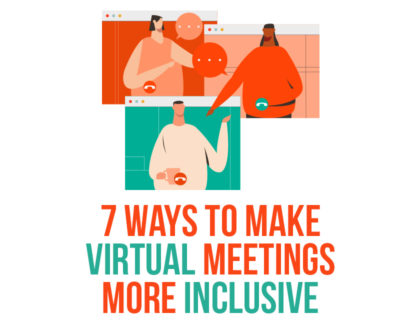Leading inclusively during a crisis: 7 ways to make virtual meetings more inclusive

In addition to disruptions to most other areas of our lives, many of us have experienced an abrupt change in how and where we work as a result of the COVID-19 pandemic. For those who are able to work remotely, this transition may come accompanied by a new set of challenges. While some people have quickly become fluent with the technology necessary for remote work, others are still figuring out how best to make the adjustment. For example, managers and employees alike may be wondering how best to run a meeting when some attendees have roommates or children nearby. Or when not everyone has access to reliable internet. In the midst of an international crisis that impacts each of us and our colleagues in unique ways, continuing to foster an inclusive workplace can feel daunting.
The good news is that many of the inclusive practices people use when leading meetings in person remain relevant and effective in a virtual context. Below are tips for translating those inclusive practices to the digital meeting space and for taking advantage of available technology so that team members of all identities feel acknowledged, valued, and supported.
1. Acknowledge and address the diverse challenges of working remotely and during a crisis.
Let people know you are aware that individuals’ experiences will vary widely during this time and that the ability to work remotely in a quiet, comfortable space is a privilege that not everyone has. Unless your workplace has provided equipment to all employees, people may not have the technology necessary for regular video conferencing (reliable high-speed internet, a working webcam, a headset, etc.).
Living situations and privacy concerns also vary by individual: many people live with roommates who may be also working from home, or they are balancing job responsibilities with caring for pets, children, elders, and/or relatives. Still, others are dealing with domestic violence or substance use, without the option to change environments. Give people advance notice if there is an expectation for them to participate via video, and send a follow-up email with notes and action items to support staff who may get interrupted during a meeting.
2. Explicitly incorporate an inclusion lens, especially around important decision-making, and remain mindful of bias.
Begin meetings with a focused statement that centers diversity, equity, and inclusion and aligns with your organization’s values. Recognize that microaggressions and bias can still occur during virtual meetings, and encourage people to reach out to you or to colleagues for support if they run into barriers that prevent them from participating fully.
Setting a precedent of open communication around decision-making can also go a long way in empowering employees during this time. For example, before announcing a policy change, emphasize that your company is seeking solutions that do not cause disparate impact and that team members should weigh in with their feedback if they think of consequences that have not been addressed. Soliciting input can help capture a decision’s potential impacts, including unintended ones, and can lead to more equitable decision-making overall. Be mindful of how you solicit this feedback. Provide anonymous or private ways for employees to submit feedback. Be mindful of power dynamics and avoid putting employees on the spot to mitigate the risk of making anyone feel like their needs and concerns are being exposed.
3. Offer micro-affirmations to proactively foster inclusion and counteract isolation.
Managers can help counteract feelings of isolation among those they manage, especially employees who hold marginalized identities. Micro-affirmations include recognizing the achievements of others, taking a genuine professional interest in staff, and asking for and listening to others’ opinions. These small, inclusive gestures can often be overlooked during times of crisis. Be sure to model them. For example, when a colleague shares an opinion in a group meeting, paraphrase what was said, ask if you’ve heard them correctly, and thank the person by name.

4. Leverage technology to capture diverse viewpoints.
Use technology tools—such as chat rooms, yes/no voting features, polling, and other in-app nonverbal feedback functions—to get input on ideas. You’ll capture the input of introverts and employees who may perceive themselves as more junior and therefore less likely to speak up.
5. Build structured participation into meetings, especially for voice-only calls.
Without the ability to see facial expressions and body language, people with marginalized identities may find it even harder to jump into a discussion during a call. In addition to nonverbal feedback options, incorporate different participation strategies, such as a round-robin, that give everyone the opportunity to speak. Prompt people to take space and make space; that is, emphasize that you want to hear input from everyone, which may mean that people who are usually the most vocal purposely shift to a listening role.
6. Delegate responsibilities so that you can focus on inclusion.
A best practice of leading inclusive meetings is ensuring all voices and viewpoints are heard. This can be more challenging when simultaneously managing technology, checking a chat room, troubleshooting, and so on. Consider holding meetings with a co-host. By sharing the work, managers can focus on facilitating the meeting and noticing which individuals the team has not heard from and which individuals have dominated the conversation. Be mindful that you don’t replicate microaggressions, such as asking individuals who have historically been delegated a disproportionate amount of “office housework,” to take notes. Although it can be easy to turn to the same few people each time for help, make sure you vary whom you task with these extra responsibilities.
7. Take advantage of 1-on-1 check-ins and supervisory meetings.
Managers have additional opportunities to build upon these inclusive practices during 1-on-1 meetings. In addition to acknowledging that staff are experiencing this crisis in varied ways, you can ask open-ended questions to learn about specific needs or concerns. Managers should listen for challenges related to employees’ physical workspace, feelings of isolation, or changes in mood and appearance. You may learn that noise-canceling headphones would make it easier for an employee to concentrate, that a colleague is in need of mental health support, or that flexible hours would help an employee to care for children in the morning. Work with each employee to ensure they have what they need to feel good about their work during the crisis. As a manager, you can use these learnings to advocate for all staff members to ensure that everyone in the office, no matter whom they report to, receives the necessary support. Your company’s leadership should observe common emerging themes that can result in the implementation of new, inclusive policies and practices.
______

As the first YWCA in the nation, YW Boston has been at the forefront of advancing social equity for over 150 years. During this time, YW Boston is working to provide organizations with digital workshops and resources to help them better understand the challenges faced by their employees. As part of that work, we are helping organizations prioritize Diversity, Equity & Inclusion and become socially connected while staying physically distant.
For more information, please contact Sheera Bornstein at sheera@ywboston.org.
About InclusionBoston
InclusionBoston advances diversity, equity, and inclusion by partnering with organizations looking for improved results. Using our advanced assessment tool and the latest research on behavioral and organizational change, we partner with organizations to create an action plan and provide them with the resources needed to drive lasting change. Our customized, evidence-based approach builds internal capacity and promotes cultural change while supporting organizations throughout their journey.
YW Boston also offers one-day workshops where participants explore frameworks, develop knowledge, and engage in dialogue.
Ready to unlock the power of diversity in the workplace? Click here to learn more about InclusionBoston and request your free consultation.
About LeadBoston
Become a part of YW Boston’s LeadBoston program and join a network of over 1,000 inclusive leaders in Boston. During this 10-month program, participants explore and learn how to address barriers to inclusion through facilitated dialogue, expert speakers, and peer learning. Through experiential activities, participants delve into the socio-economic realities of Boston and explore innovative solutions to inequity.
